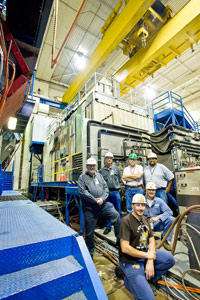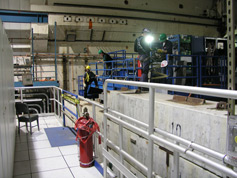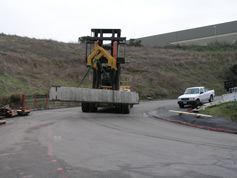
Handy Links
SLAC News Center
SLAC Today
- Subscribe
- Archives: Feb 2006-May 20, 2011
- Archives: May 23, 2011 and later
- Submit Feedback or Story Ideas
- About SLAC Today
SLAC News
Lab News
- Interactions
- Lightsources.org
- ILC NewsLine
- Int'l Science Grid This Week
- Fermilab Today
- Berkeley Lab News
- @brookhaven TODAY
- DOE Pulse
- CERN Courier
- DESY inForm
- US / LHC
SLAC Links
- Emergency
- Safety
- Policy Repository
- Site Entry Form

- Site Maps
- M & O Review
- Computing Status & Calendar
- SLAC Colloquium
- SLACspeak
- SLACspace
- SLAC Logo
- Café Menu
- Flea Market
- Web E-mail
- Marguerite Shuttle
- Discount Commuter Passes
-
Award Reporting Form
- SPIRES
- SciDoc
- Activity Groups
- Library
Stanford
Around the Bay
Safe '08: BaBar Shield Wall
Piece by 16-ton piece, SLAC riggers and BaBar engineers dismantled a 27-foot high, 450-ton cement wall. The massive structure served as the radiation shielding wall for the BaBar detector and has been constructed and destructed many times since the detector was put in place. Through careful work planning and control, the team took all necessary precautions and maintained constant safety awareness. They completed the task with no injuries or accidents.
To bring down the towering structure, the crew had to lift and remove 28 16-ton blocks, each the length and width of a pickup truck but about three times the weight. Nine smaller 1.5-ton blocks also had to be removed from the cavernous BaBar detector hall. Project Chief Engineer Jim Krebs and more than half the team have participated in previous deconstructions. "We've done this job before, but we don't get complacent," he says. "We still pay close attention to safety issues."
Before work began, Particle Physics and Astrophysics safety coordinators analyzed the hazards for the two riggers who would climb on top of the wall and secure the cement blocks to the overhead crane. "This was really the number one safety issue," says Krebs. These hazards, and the established controls to mitigate them, were written down and discussed in an Elevated Surface Work Plan.
To prevent falls, riggers Gibson Locke and Scot Johnson strapped on full-body harnesses, which secured them to lanyards anchored to the BaBar detector. The two riggers ascended the wall via a staircase. High above the hall floor, the riggers performed the crucial task of securing the blocks to the bright yellow crane that is mounted into the frame of the building. The crane’s claw-like hook slipped around a heavy-duty sling attached to a strong steel shackle. The riggers secured the shackle to built-in eyelets on the blocks, and guided the great masses as they rose into the air.
Crane operator Dave Engesser evaluated the weight of the blocks, identified the lifting capacity of the crane, forklift, slings and shackles, and certified that each piece of equipment was sufficient to hold the huge masses. He submitted this information as a Lift Plan to Environment, Safety and Health representatives before work began. SLAC requires all its crane operators to be safe and skilled at their job, but the extraordinary load size motivated the management team to recruit Engesser, who is one of SLAC’s most experienced operators. Having worked as a SLAC rigger for almost 22 years, he operated the BaBar crane during every disassembly of the wall. Engesser says familiarizing himself with the crane means having a feel for how it moves. By carefully controlling the speed of the crane, he ensured that the elephantine load did not swing as he guided it across the hall and set it down.
The crew cleared the hall of additional personnel and stayed clear as the suspended blocks made their way across the building. As the crane slowly lowered each block to the floor, crew members stood a safe distance away and took into consideration where the block would move in the unlikely event that it began to swing or fell in midair. Every block touched down without incident.
The team waited patiently as the blocks settled onto the floor. After touch down, the crew unhooked the crane support and secured the block to the Hyster forklift—SLAC’s second largest forklift, which itself weighs more than 50 tons. Will Anderson drove the Hyster, which holds the block from above with a sling, much like the crane. Anderson drove the block up the steep incline outside the BaBar detector hall and placed it gently down at its temporary resting place for storage.
The management team took one more step to assure safe execution of the deconstruction. A handful of crew members worked as overseers to keep an eye on each task being done. Krebs acted as an overseer to the hoisting and rigging. "We're there to help," says Krebs. "We make sure everyone is doing their job right; we look to make sure they don't miss something."
Standing watch over the project as a whole was ES&H newcomer Don Dains. Dains was the only team member participating in the deconstruction of the wall for the first time. "Everyone was very helpful and open to suggestions," he says. "The SLAC safety culture is very cooperative."
This is the fourth time crews have taken down the great wall since 2000. The experienced team members understand the process well and can move a single block in about 20 minutes. "They did move the blocks expeditiously but they did not rush," says Dains. "I was impressed by the amount of care that was taken and by the safety consciousness of the entire crew."
—Calla Cofield
SLAC Today, September 30, 2008


